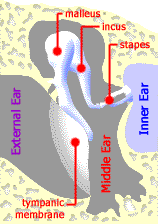What is Otosclerosis?
Otosclerosis is a condition of the middle ear that causes hearing loss which gets worse over time. Unlike hearing loss resulting from damage to the inner ear, the hearing loss from otosclerosis is often reversible. The name otosclerosis comes from the Greek words for “hard” (scler-o) “ear” (oto). This is because otosclerosis is a disorder which causes a hardening of the bones of the middle ear. To understand why otosclerosis causes hearing loss, it is important to understand how the ear works.

The human ear is divided into three parts: the external, middle, and inner ear. The external ear consists of the part of the ear you can see (the auricle) and the ear canal.
The middle ear includes the eardrum (tympanic membrane) and the three bones of the middle ear, the malleus (“hammer”), incus (“anvil”), and the stapes (pronounced STAY-PEAZ, “stirrup”).
The inner ear is a fluid-filled series of chambers. One of these chambers, the cochlea, is responsible for converting sound vibrations into nerve impulses. It is these nerve impulses that the human brain interprets as sound and what we call “hearing.” The inner ear also contains the semicircular canals which are responsible, in part, for sensing movement and maintaining balance.
Normally, sound is conducted from the outside environment through the ear canal. Sound waves vibrate the tympanic membrane and set the bones of the middle ear into motion. These vibrations are transmitted from malleus, to incus, to stapes, and finally to the fluid of the inner ear. When everything is working normally, the hearing is normal.
However, if the bones of the middle ear don’t vibrate normally, the inner ear does not receive the full amount of sound vibration and hearing is decreased. This is exactly what happens in otosclerosis. Most cases of otosclerosis involve the last and smallest bone, the stapes. Notice in the illustration to the left that the malleus and incus are moving normally, but the stapes is motionless or “fixed”. In otosclerosis, the bottom of the stapes becomes calcified or hardened by overgrowth of new bone. It is unknown why this occurs.
What are the symptoms?
The primary symptom of otosclerosis is a slowly progressive hearing loss beginning anytime between the age of 15 and 45, although it usually starts around age 20. Approximately three-quarters of patients with otosclerosis will also develop a ringing or rushing sound in the affected ear, also called tinnitus. In 25-30% of patients, balance problems may also occur, including unsteadiness, dizziness, vertigo, or other sensations of motion. Otosclerosis affects both ears in 80% of patients.
Who gets otosclerosis?
Otosclerosis affects approximately 10% of the adult Caucasian population. However, only 1% of people will ever develop significant hearing loss as a result of this condition. The condition is less common in people of Japanese and South American decent. It is rare in African Americans.
Otosclerosis affects women twice as often as men. In female patients with this disorder, hearing often worsens rapidly during pregnancy. Many cases of otosclerosis are genetic and approximately 60% of cases run in the family.
How is otosclerosis diagnosed?
A simple hearing test is usually all that is required to diagnose this condition. However, since there are a number of middle ear conditions that cause hearing loss, there is often no way to be absolutely sure that a patient has otosclerosis without actually looking into the middle ear. This must be done in the operating room as a surgical procedure known as a middle ear exploration or exploratory tympanotomy.
Patients who have balance problems in addition to hearing loss may need additional balance tests prior to surgery.
What is the treatment for otosclerosis?
The primary treatment for otosclerosis is surgery. Surgical treatment for otosclerosis has been around since before 1900, with the modern era of otosclerosis surgery beginning in 1952. Since that time, a number of procedures and modifications have been devised to correct the problem of stapes fixation. Today, most otosclerosis surgery involves removing part (and sometimes all) of the stapes and replacing it with a prosthesis.

In a surgical procedure called stapedectomy (or more correctly stapedotomy), the top portion of the stapes bone is removed by breaking it or vaporizing it with a LASER. The bottom part, or footplate, of the stapes remains fixed in place by the otosclerosis. A small hole is then drilled in the footplate . A small prosthesis is then inserted into the hole and attached to the incus. One of the most common prostheses used looks like a small piston with a wire attached to the top. The piston goes into the hole in the stapes footplate and the wire is hooked onto the incus and tightened to prevent slipping. Notice how the piston is free to move in and out of the inner ear through the hole in the stapes footplate.
The entire procedure is performed under local anesthesia in the operating room and takes approximately 45 minutes. Hearing is improved immediately, although packing placed into the ear canal at the end of the surgery prevents patients from experiencing their new hearing for a week or so.
For patients who cannot undergo surgery, hearing aids are usually very effective in restoring near normal hearing. Sodium fluoride, a medication taken as a pill, is also helpful in slowing the progression of the disease.



